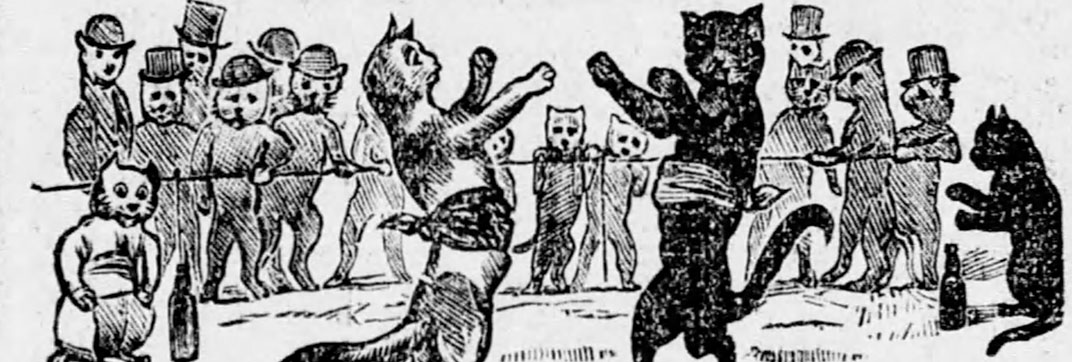The Battle of the British Variety Cat Acts
If you’re at all interested in historical film you’ve probably come across footage of cats “boxing” in miniature rings, complete with padded paws and a referee (or rather a trainer) attempting to control the action.
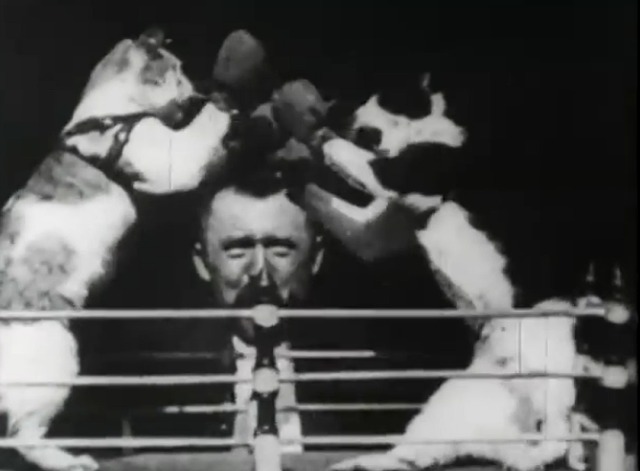
If you look closely at the various footage of boxing cats we have already covered, you may have noticed that this wasn’t just one person and the same cats. And it wasn’t confined to just one era. Boxing cats appeared to be a novelty for many years with different people across the decades jumping on the bandwagon.
But just when did this become a popular attraction? And why?
It’s hard to say exactly when the first person made an entertainment by sticking two cats in a ring and charging people to watch them “box.” We could find no newspaper references to the practice dating before the late 1880’s. But around the same time that English Music Hall developed into Variety Theatre and moved into more luxurious venues such as the London Pavillion and the Empire, Leicester Square, an interesting trend emerged which led to a heated rivalry, some extremely talented feline performers, and a shocking tragedy that would rock one famous training couple to their core.
It appears that one of the first people to put cats through their paces on the stage was Edward Bonetti (usually spelled Bonetty in the trade ads). Oddly enough he did not have a history in show business, having been born in Amsterdam and starting out as an assistant in a draper’s shop. Bonetti read in Buffon’s Natural History that cats, “owing to their stupidity and obstinancy,” were untrainable. He set out to prove that theory wrong and started spending all of his spare time training cats, which won him no favors in his chosen business.
In a large granary, Bonetti continued to train cats to perform intricate tricks. Since the place also had its share of mice and rats he soon incorporated these critters into his training regiment. Eventually he added a canary and the seed of a new form of entertainment was born, although he could not have known at the time how popular this assemblage would prove to be.
Bonetti started performing with his animals in public around Europe circa 1887. It was during one of these tours that the act was spotted by W. Fredericks, who told the Pall Mall Gazette how he got the idea to train cats from Bonnette (spelled differently yet!) and set about creating a troupe of his own. Fredericks had a history on the stage, and knew how to adapt the performing animals formula and bring it to the theater. On July 21, 1888, an announcement appeared in The Era (a trade magazine for all things to do with variety, vaudeville, music hall and show business) proclaiming the opening of his new act. Since Fredericks was currently with a circus in Spain, his address was located there, but his agent, R. Warner, was located in London:

After running similar ads for two weeks, Fredericks was probably surprised to see ads next to his starting on July 28, 1888, announcing the impending debut of a similar sounding novelty act introduced by Mr. Leoni Clarke, the self-proclaimed Cat King.
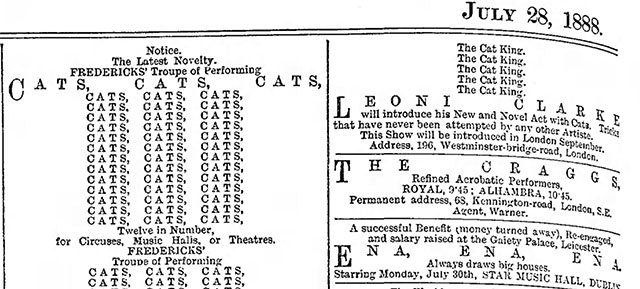
Oddly enough, Fredericks agent R. Warner would soon become Clarke’s agent and Fredericks would be represented by G. Ware, who was formerly Clarke’s agent!
Leoni Clarke had a long history in English entertainment, having been part of an aerial clown act with his partner Selvini as far back as 1880. The act later changed its name to “All Right Up to Now” with the tagline, “Still alive,” although Clarke was now performing with Funny Rossini, adding stilt walking to their list of talents. Over the years Clarke adapted his act, billing himself as a juggler, gymnast and equilibrist (or tightrope walker.)
By June of 1882, Leoni Clarke had added yet another element to his act. At The Pier in Hastings his act consisted of juggling and performing pigeons. By November 1882 he had added a Cockatoo to the turn. One notable trick that brought some noteriety was a revolver trick in which he would fire four or five shots from a revolver with a pigeon standing on the barrel. While still billed primarily as a juggler, the pigeon part of the act continued to grow. By 1885 he was being billed as “The Bird King” and labeled “the only acknowledged Champion Pigeon Charmer of the World.”
So Clarke was already a well-known animal trainer. It’s not clear how or when he turned his attention to cats, but possibly he either saw or heard of Bonetti’s act around the same time as Fredericks and set out to train his own troupe of cats, rats, mice and canaries. However it came about, Clarke was only barely behind Fredericks in debuting his act in England. Clarke was apparently in Dublin perfecting his troupe when Fredericks announced his act, which he claimed had already been applauded by all the Royal Family in Lisbon as well as a huge hit in Madrid. But Clarke was quick to announce his new show, and undoubtedly had the history and connections to edge out Fredericks. He was already publishing notices for his performances in Dublin, such as this one from the Dublin Evening Telegraph (note that Chevalier Blondin was a popular tightrope walker of the time and the term “Blondin Cats” became common in these acts):
The Star Theatre of Varieties — Seldom has a performance obtained so great a success as that of Mr. Leoni Clarke’s troupe of trained cats, rats, mice, and canaries, whose various acrobatic feats fairly nonplussed the public who expressed their surprise at the result achieved by Mr. Leoni Clarke, who, in this his first appearance, reaped the fruits of a long and arduous attempt to take that which heretofore had been regarded as tameless, and to bring together, in perfect harmony, a collection of animals whose animosity is by nature of the strongest character. To see cats performing the Blondin feats with rats, mice, and canaries on their backs is sufficient to convince one that man is still the king of creation, and that courage and perserverance will surmount all difficulties. Mr. Leoni Clarke has scored a big success, and deserves ample credit for it. Star Music Hall, Dublin
So in the fall of 1888, the Era saw the beginning of a kind of rivalry between three acts, all claiming to be “one of a kind” but with practically the same features. Fredericks’ ads, up until the time of Clarke’s debut, were longer, more detailed and elaborate. One such ad from August 18, 1888 even announced the names of the cat performers:
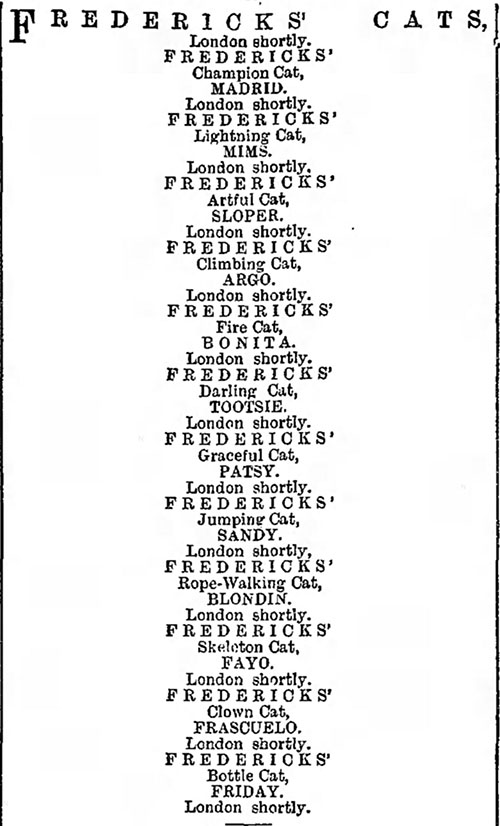
Professor E. Bonetty also advertised in The Era on September 1, 1888, stating the names of some of his cat performers as well. Note that Bonetty not only had two Blondin Cats but claimed he was training cats to ride horseback and perform on double cross bars as well as the trapeze (quite a feat for animals with no opposable thumbs!)
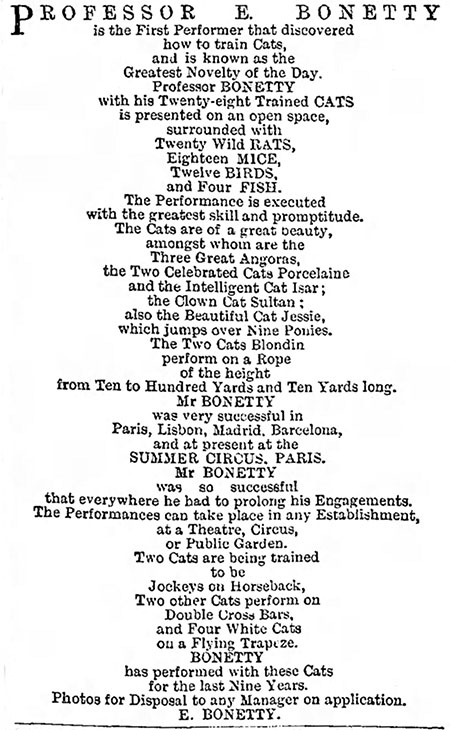
Fredericks was booked in two venues, the Canterbury and Paragon in September 1888. An interview published in the Pall Mall Gazette around this time explained Fredericks’ method of training and described the act (note how Fredericks is referred to as Professor. This was something which regularly occurred with cat trainers, although what exactly they were supposed to be Professors of we’re not sure!):
The twelve cats comprising the troupe which made their debut the other evening at the Canterbury and Paragon Music Halls, are one more instance of the extraordinary results that may be achieved by a trainer who thoroughly understands his business; and when it is mentioned that in addition to walking along a row of champagne bottles, the corks of which are supplanted by stoppers with a flat surface somewhat larger than a crown piece, jumping through ignited hoops, ascending and descending a good-sized pole temporarily erected in the centre of the stage, walking on a tight-rope, first without any obstruction thereon and later on picking their way gingerly across the same, taking the greatest care not the ruffle the serenity or alarm the susceptibilities of certain rats, mice and canaries, placed at intervals along the same, to say nothing of other minor efforts in various directions, it will be admitted that the “Professor” has something to be proud of.
I found the Professor (says a correspondent who has interviewed him) in the small yard at the rear of the hall engaged in supervising the morning toilet and general comfort of the feline members of his troupe, and at once announced my desire of learning as much of his “system” as he felt disposed to communicate. “I may tell you at once,” he said, “that the idea of training cats to perform in public as mine do did not originate with myself, although I am, I believe, correct in saying that beyond these you see before you there is at present only one other similar troupe in existence, and they are just now being exhibited on the Continent by Prof. Bonnette, who came out some 12 months ago; and it was from him some four months later that I got the idea, and set about training a similar troupe on my own account.”
“These cats,” I said, “do not give me the impression of being ‘quite English, you know'”
“No, they are not, not one of them; I was with a circus in Madrid when I formed the idea of having a troupe as an extra attraction, and I got all my cats there. Most of them are from the Angora breed, but I don’t see why the British cat should not do as well as a foreigner, and I am going to experiment on one or two very shortly.”
“Had you any difficulty in getting them?”
“Not the slightest. I could have double the number if I wanted, and as a matter of fact I have had upward of 20 altogether; one or two have died, and the rest proved useless for training, but all these (12) are as good as I can desire.”
“Most of them appear young.”
“Yes; the oldest is only 2 years old, or rather more, perhaps; and the youngest not above 3 months; he does not do much yet, but he will be as good as either of them in another month or two.”
“What age do you prefer to have them at for training purposes?”
“It really does not matter much. I have had them as young as 8 or 9 weeks, and as old as one-and-a-half years. That one there — pointing to a well-conditioned light tabby — is one of my best. Boneta, I call him, and next to Mims (a tortoiseshell). He does the pole trick, the most difficult thing of all to teach; and yet, although Boneta was a year older than Mims when I had him, I don’t know that he wasn’t the easier of the two to train. Taken all round, I should say about six months old is the best time to begin training at. Of course, it is as well to have them younger, so as to get them thoroughly well-accustomed to you.”
“And how do you set about training them, may I ask?”
“First of all I get them as fond of me are they are capable of being, (which is not saying much, for I don’t believe cats have any real affection whatever), and having done this the rest follows easily enough by degrees. You mustn’t expect to do it all at once, but any cat of average intelligence can be trained to do almost anything in nine or ten weeks. Feeding and coaxing does it. If you attempt to resort to harsh measures it is all up. They turn sulky directly.”
“What is the first trick you teach them?”
“To sit up and beg, and then feed them when they do it well; then creeping through the chairs and gradually walking over the backs, and so on. When they have once begun to learn and find they get bits of meat when they do a trick neatly, they give very little trouble after.”
“What about the rats, mice, etc.? Do your cats appear antagonistic to them at first?”
“Not a bit. I have had a cat that has been taught to walk the rope the first time the mice or rats have been put on, just to knock them off with her feet so as to get them out of her way, but not show the slightest desire to hurt them; and the same way with the birds. One of the greatest difficulties I have to encounter is to teach them (the cats) to lift their feet up so as not to upset the rats or birds.”
“And the rats, birds, etc., do they mind?”
“Not a bit; they don’t take the slightest bit of notice of the cats so long as they don’t tread on them. They are not the least afraid; in fact it is a case of neutrality on both sides.”
“And the pole trick; how do you manage that?”
“Well as a rule that is the most difficult thing of all. You see a cat may be made to go up a little way, say; and there she sticks, won’t go up or come down; and you can’t do anything in the same way as you could if they are performing on the chairs or the tight-rope, where you can reach them. Of course, there is always a bit of meat at the top of the pole; otherwise they would not go up at all; and even with this inducement they usually make a great fuss, especially the coming down head-first.”
“Have you ever had a cat fly at you?”
“No, I can’t say I have; they have given me some nasty scratches before now, as well as bites, but I don’t mind that. If they turn sulky I let them alone, coercion is no good in their case, and force is not a remedy. You must just let them have their sulk out, and then start again.”
“Do you consider cats easy to tame or otherwise?”
“Most decidedly otherwise. I have trained all sorts of animals and birds, and, next to a goat, (which is, I verily believe, the most obstinate creature in the world to instill an idea into), cats most certainly are entitled to a second place. You can never get them to take an interest in their work; they do it, and do it well enough generally, but they do not take a pride in what they do like a horse or a dog — that’s the point.”
But Clarke was on the ball and, likely to Fredericks chagrin, was booked in October 1888 at the London Pavillion. An interview with Clarke was included in the December 15, 1888 edition of the Huddersfield Daily Examiner:
Some Clever Cats
Interview of a Pall Mall Gazette Representative with Mr. Leoni Clarke
“Any morning at half-past eleven I shall be glad to show you my cats practicing and to have a chat with you.” So wrote Mr. Leoni Clarke, and at half-past eleven the next morning I met him on the stage of the Pavilion to witness the rehearsal. I found Mr. Clarke hard at work in his shirt-sleeves rigging up his apparatus, and planning some improvements. “I have always to be making out something new,” he said, “and unless my troupe are put through their drill every day they would soon get out of practice. The young ones have to be taught, and the old ones kept up to the mark, so I’m generally pretty busy. Where did I begin this business? Well, I made a start with it at a Dublin music hall. The first night there were any amount of bets offered that my cats would go off helter-skelter as soon as they faced the band and audience, but I was ready for that. I had heard of a Frenchman that trained a troupe of cats, and the first night they all bolted. So for a good month before our first public appearance I had a band play every day to my cats, and a lot of boys talking and kicking up no end of row while they practiced. At last they got quite used to the noise.”
By this time the cats are arriving. They are brought down from their comfortable quarters at the top of the house in five large covered baskets, and the first step is to transfer them from these baskets to the shelves of a couple of wooden houses or sheds at either side of the stage. They make their entries and exits before the audience by little doors like pigeon-holes, and an assistant stationed in each house keeps them from quarrelling, and acts the part of call-boy by sending them on at the proper time. As each basket is opened one sees a variegated mass of soft fur, out of which six heads project and six pairs of bright eyes look up with a quiet, self-satisfied air that tells of kindness and good treatment. There is no anxious cowering anywhere. And from the outset there is proof of good training. The cats do not jump out of the baskets. They wait till they are handed one by one to their places. As they are passed along Mr. Clarke asks me to feel the weight of them, especially one shaggy animal from Russia answering to the appropriate name of Moscow, the giant of the troupe. “I have a bigger one at home,” says Mr. Clarke; “I feed them well; they have a right to a fair share of what they earn — and they get it.”
Inquiring further as to their diet, I learn that they have two good meals a day — at 10:00 a.m. and 6 p.m. — so that there is time for a rest before the morning rehearsal and the evening performance. It was quite a mistake to suppose that animals will be more tractable by being half-starved, and these clever cats have hard work to do, which requires a liberal diet; so they are regaled with meat, fish, and milk “ad libitum”, the menu changing every day.
Twenty-five pussies attend at the rehearsal this morning — all colours, all ages, all sizes, from big black and white Moscow down to a pair of little kittens just able to get about. There are also several nationalities represented — English and Manx cats, two Russians, one Spaniard, a long-limbed white and tortoiseshell cat that is the liveliest player of the lot. Fireworks is the name of this Spanish lady; she comes from Valladolid, and she quite deserves her name. “Eight-toes” is the appropriate name for another puss, a black and white, with eight perfectly formed toes and claws on each of her forepaws, a malformation which gives her some advantage in rope-walking. They cross and recross the stage, transversing it on the tops of a row of champagne bottles; they bound through wire hoops, they walk a tight rope, they scramble up and down cloth-covered boards placed almost at the vertical. In walking the tight-rope they have to pick their way among white rats and mice and canaries perched at intervals on the rope, a feat which recalls the “happy family” of the streets.
In the evening only the finished performers appear before the public, but at the rehearsal, learners of all ages are put through their drill. Mr. Clarke does all his work by gentle means. Patience and kind encouragement are his methods. There is no bullying or scolding, and feline pupils are never struck. If they succeed there is a pat on the head, and a “Bravo Sweep!” “Well done, Spot!” from their master. If they hesitate or bungle, they are helped and encouraged. “Come on, puss; come on, love, it’s quite easy, you’re halfway across already,” and then pussy is lifted over the difficult jump. She learns the trick by being put through her drill until she does it herself. The sight of the other performers is of course a help. Now and then one of the cats would stop timidly, and express her feelings by a low, prolonged mewing. One of them came to a halt in this way on the high rope; a kind word of encouragement from Mr. Clarke was enough to start her again. He takes good care of his favourites, and has an ingenious contrivance by which a little platform can be run along the high rope to afford temporary foothold to a feline rope-walker in difficulties.
Every cat seems to have a different character. Some, like Fireworks, are eager to be out on the stage, and do everything at a rush. Others go through their performance quietly and steadily as if it were a matter of duty. Some walk the rope on the bottle tops with a jaunty air, others creep across. Some learn quickly, others slowly, and there are actors in the troupe whose training cost a year of patient teaching. All have to begin young, and with all the same method is observed — good treatment and uniform kindness.
The performance over, the cats are replaced in their baskets and carried up to their quarters at the top of the house — a clean, airy room, where a luncheon of hot milk is waiting for them. They are no sooner turned out of their baskets then some lie down for a sleep, others begin to play with the kittens, others again are washing their furry coats. It is a very happy family, and they are quite ready to make friends with their interviewer. One big tabby Tom, indeed, is so demonstrative, and hangs on so affectionately to my overcoat, that it is not easy to get away from him.
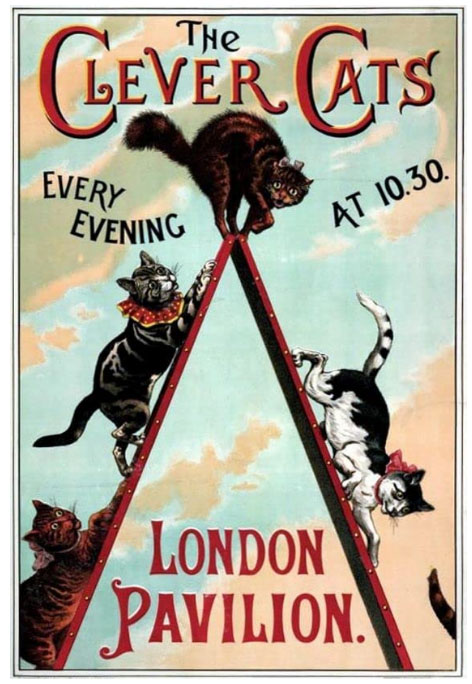
With the two troupes of Performing Cats now engaged, the war of ads only heated up. We should interrupt a moment here to explain the elaborate nature of some of these ads and the reason behind them. When one looks at the pages of The Era it is mostly comprised of multiple columns of classified ads regarding everything to do with the theater, from acts to props to drapes to fixtures. You can only imagine how difficult it would have been for struggling acts to get noticed within these pages. One trick adopted by many was to lay out their ads with unique typesetting which utilized the letters to form larger words or designs. You can see the effectiveness of this method on the page below (although one wonders how the publication’s typesetters felt about these inventive layouts):
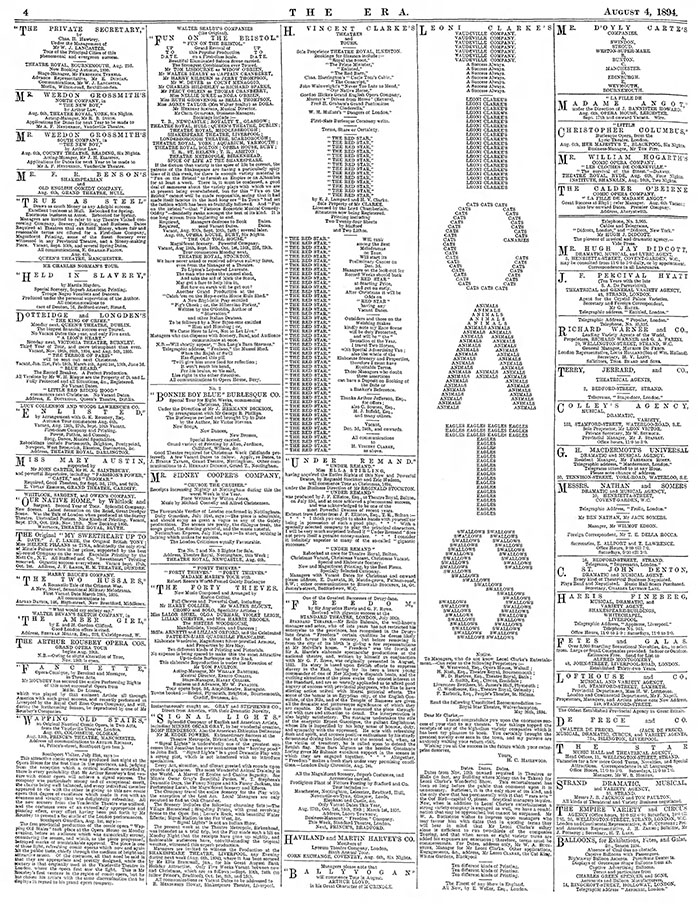
Fredericks, now billing his show as “What Cats Can Do,” added new venues to his dates, often appearing in different theaters on the same night. Implying a connection, friendship and understanding between the two acts, advertisements for Mr. Edward Bonetti often appeared right below Fredericks:
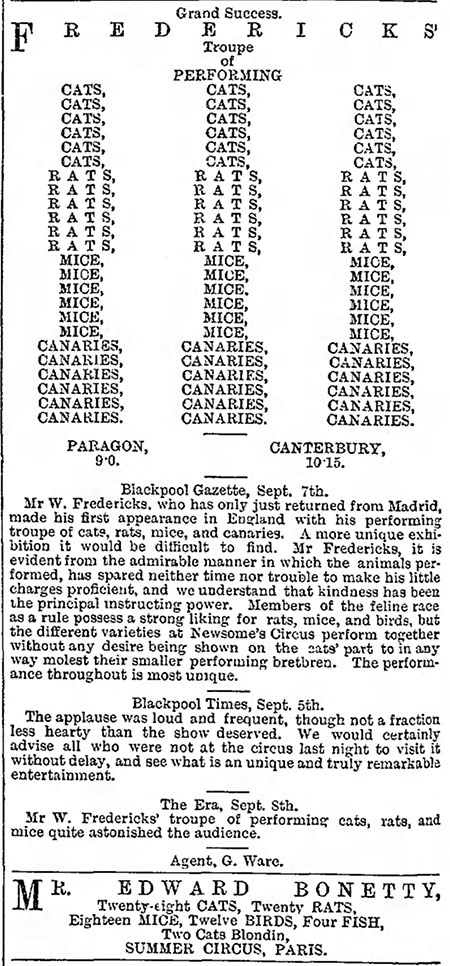
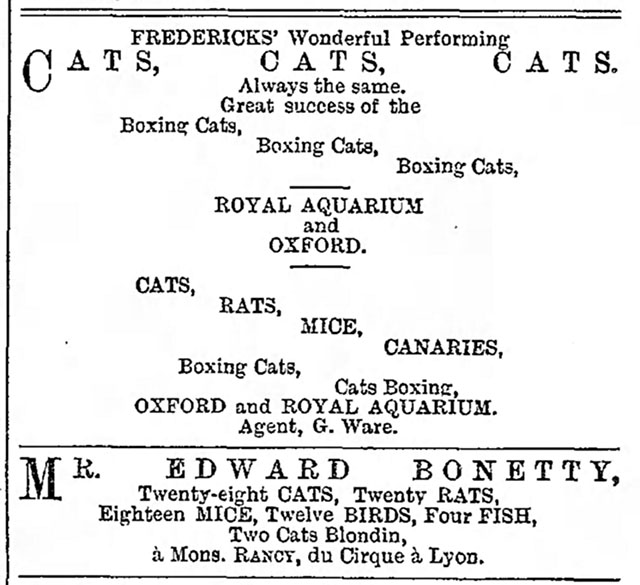
Clarke countered, calling his show Clarke’s Clever Cats, and the number of performing animals kept rising. What’s more, ads for the Beautiful Bird Queen, Mademoiselle Tina and her Marvellous Troupe of 100 Birds often appeared directly below Clarke’s ads. Tina was actually Clarke’s wife and had apparently taken over his bird act when he moved on to cats.
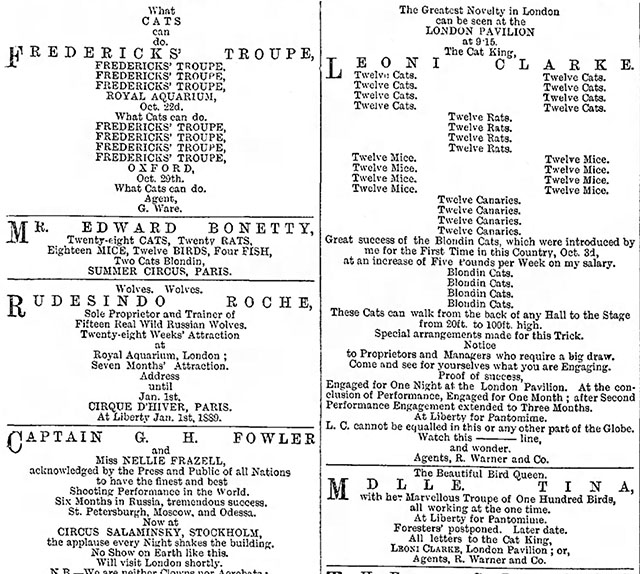
The advertisers, Fredericks and Clarke, began to reference one another in not too subtle jabs which started out with comments about how their acts were superior to all others. Note this segment of text from Clarke’s ad posted above:
The Greatest Novelty in London can be seen at the London Pavillion at 9:15, The Cat King. Great success of the Blondin Cats, which were introduced by me for the First Time in this Country, Oct. 3rd. at an increase of Five Pounds per Week on my salary. Blondin Cats — These Cats can walk from the back of any Hall to the Stage from 20 ft. to 100 ft. high. Special arrangements made for this Trick. Notice, to Proprietors and Managers who require a big draw. Come and see for yourselves what you are Engaging. Proof of success, Engaged for One Night at the London Pavillion. At the conclusion of performance, engaged for one month; after second performance engagement extended to three months. At Liberty for Pantomime. L.C. cannot be equalled in this or any other part of the Globe.
In November and December of 1888, two notable changes were made to the acts. In an ad published on November 24, 1888, Clarke first mentioned the addition of a “Baldwin Cat” to his show (a man named Tom. Baldwin had garnered fame in 1887 by parachuting from a hot air balloon). He also openly challenged his rival acts with this statement:
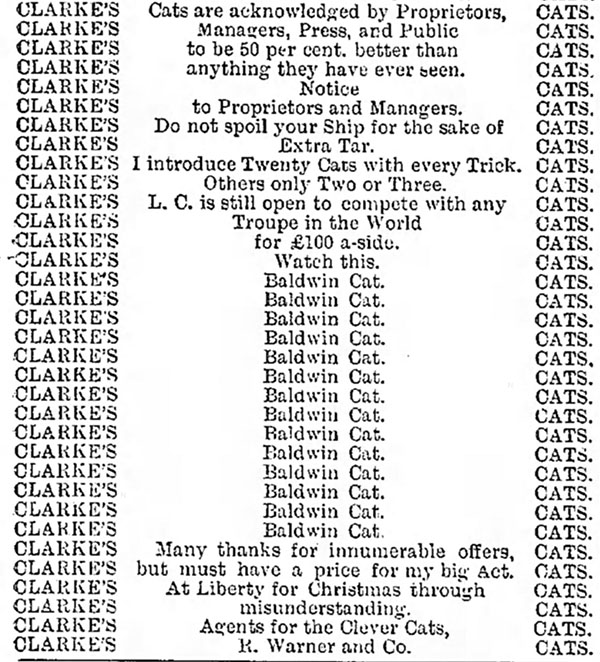
The Baldwin act was described in The Strand Magazine – 1894 this way:
The Training of Performing Animals by E.A. Brayley Hodgetts
Take, for instance, Professor Leoni Clarke’s “Baldwin” kitten, which climbs up to the roof of the theatre or circus where the performance takes place, gets into a parachute of itself, and then drops down, to be caught by Professor Clarke. To see that kitten slowly climb the rope, and stop every now and then to pause, is most thrilling. There can be no doubt of its unwillingness to ascend, and when it reaches the top it hesitates before getting into the parachute; it seems to reflect and ask itself whether it would not be wiser to climb down again rather than trust itself to that apparatus; but it overcomes its natural unwillingness and gets in with an air of heroic determination which is most pathetic. That “Baldwin” kitten is one of the prettiest animal performers I have seen. No cruelty would have succeeded there. Professor Clarke’s musical cats, who play “Home, Sweet Home” on sleigh-bells, are perhaps more cultured, but they are certainly less pathetic. The same may be said of his rats, who take their seats in a train and enjoy the excitement of a railway accident.
On December 1, 1888, Fredericks’ ad was the first to mention Boxing Cats as part of his show. Amazingly enough, Clarke’s ad in the very same section states “Has the best Boxing Cats in the World.”
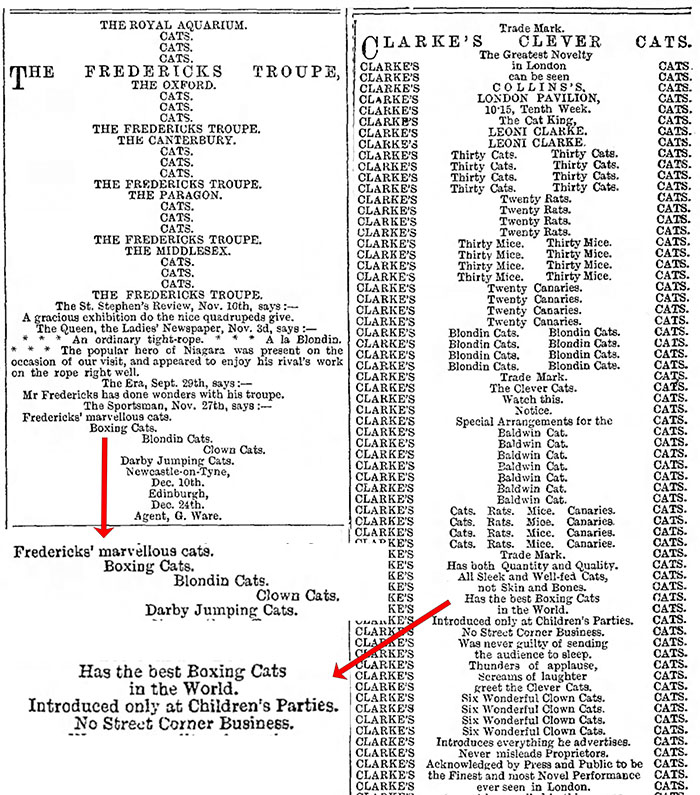
Leoni Clarke also made more jabs at his rivals, claiming that all his cats were sleek and well-fed, not skin and bones, also adding, “Introduces everything he advertises. Never misleads Proprietors.” A following ad on December 22, 1888 claimed that “Leoni Clarke has settled all other Cat shows. 30 cats, 24 rats, 30 mice, 20 canaries. Concluded Dec. 15th with the Clever Cats at the London Pavillion, a most successful engagement of Twelve weeks duration.”
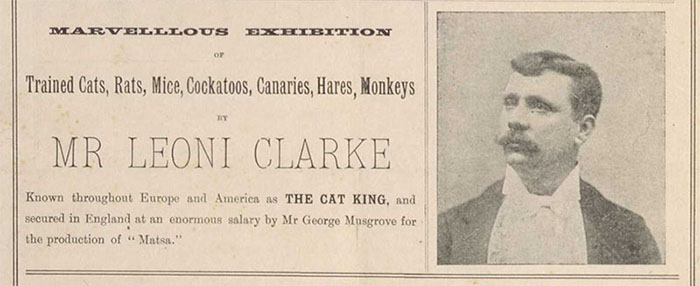
Just when Clarke seemed to be getting the upper hand, Fredericks (now at the Waverly Market in Edinburgh) was given a timely Christmas present with a full page illustration by none other than Lois Wain in the Illustrated London news on December 22nd, 1888. The accompanying article surely must have made Clarke green with envy:
Professor Fredericks’ Performing Cats
We all have our hobbies, which our friends, if they are wise, suffer gladly. Professor Fredericks’ hobby is animals. The horse, the pony, the goat, and the pig have all from time to time come under his influence. Just now he has a preference for the domestic cat. He possesses a large number, of all breeds and sizes, which are conveyed from his house to the place of performance each day, are exercised most mornings in his back garden, and are fed on cats’-meat and bread-and-milk. Some of them persistently prefer the latter dish. The pride of the flock is a black animal named Sloper, who originally cost his master sixpence. A fifty-pound note would not buy him to-day. This treasure is just now suffering from a severe cold, and Professor Fredericks has been obliged to put a mustard plaster on his throat. Of all animals, horses and dogs are the easiest to train. Cats are willing enough to learn, but they are unreliable. Sloper may have walked the tight-rope five nights with elegance and precision, but on the sixth he refuses. “It’s obstinancy,” says Professor Fredericks; “and when the fit is on them, the only way is to let them rest. I never use force, and never be any chance strike an animal.” For training purposes, kittens are useless. They are too enterprising. Professor Fredericks prefers a middle-aged Spanish animal, whose sense of humour is not abnormally developed. Cats can be trained to care little about the audience, and they are perfectly indifferent to applause; but they do not like any alteration in the aspect of the stage. If a stranger happens to cross the boards, they will pause and look round with a serious inquisitiveness which is inimitable.
The first item of the performance at the Oxford and the Aquarium was climbing the pole; this, of all cat tricks, is the hardest to teach, as with the first step the animal passes out of his master’s jurisdiction. Whether he reaches the top of the pole or not depends entirely upon his own humour. On this occassion Arco — a tall, thin, lank Portuguese cat — was in fine form: he climbed the pole, and came down head first, without so much as a mew. Walking the tight rope followed; this half a dozen animals — English and Portuguese — accomplished skillfully, with occasional encouragement from their master.
If there is one thing of all the others that Sloper most dislikes it is mice, and next it is the canary birds. He treats both of them with contempt. One of the striking features of the performance was to see him walk a tight rope literally strewn with these animals. He lifted his feet gingerly over mice and birds, and the little mishap that occurred in the second part of the journey was due entirely to his severe cold. He sneezed one of the canaries off the rope and onto the floor; but he made up for it by returning with a mouse on his back. It will be news to most people to hear that one cat in eight has no taste for birds and mice. When the taste has been acquired, nothing save downright bullying and cruelty will correct it, and that method of training has no place in Professor Fredericks’ system. Quite recently a black and white member of the company, named Aquarium, by a clever piece of business, nearly succeeded in ousting Sloper from his position as leading juvenile of the show. In a moment of forgetfulness, let us hope, he bent his head and caught a rat in his mouth. The little animal, no doubt, gave itself up for lost. A word from Professor Fredericks, however, and it was dropped at once.
Mention must also be made of the boxing cats. They stood on their hind legs facing one another on two chairs, and fought three rounds in the most scientific fashion. Professor Fredericks finds that Portuguese cats make the finest performers, and the Lisbon folk the best audiences. In that city cats are adored, for the reason that they act as scavengers in clearing the streets of innumerable mice that infest them. Their lank and lean appearance is due to this pursuit, and not to severe treatment, as English audiences are apt to imagine.
Professor Fredericks is able to train one in three cats, those of a black hue taking most readily to the work. He first teaches them to sit up and beg; creeping through a chair follows, which leads to crawling over the backs, and so on to walking across the stage on champagne bottles. The Professor believes that cats have no real affection at all. It takes a canary about five weeks to get used to its natural enemy.
There is not on record a single instance of a Radical cat. They detest change, and if taken to a new home will hide under the chimney till custom has soothed their fear. It is one thing for a cat to perform in a private room, but quite another to make him go through his tricks in a public hall, as one or two cat showmen have found to their cost.
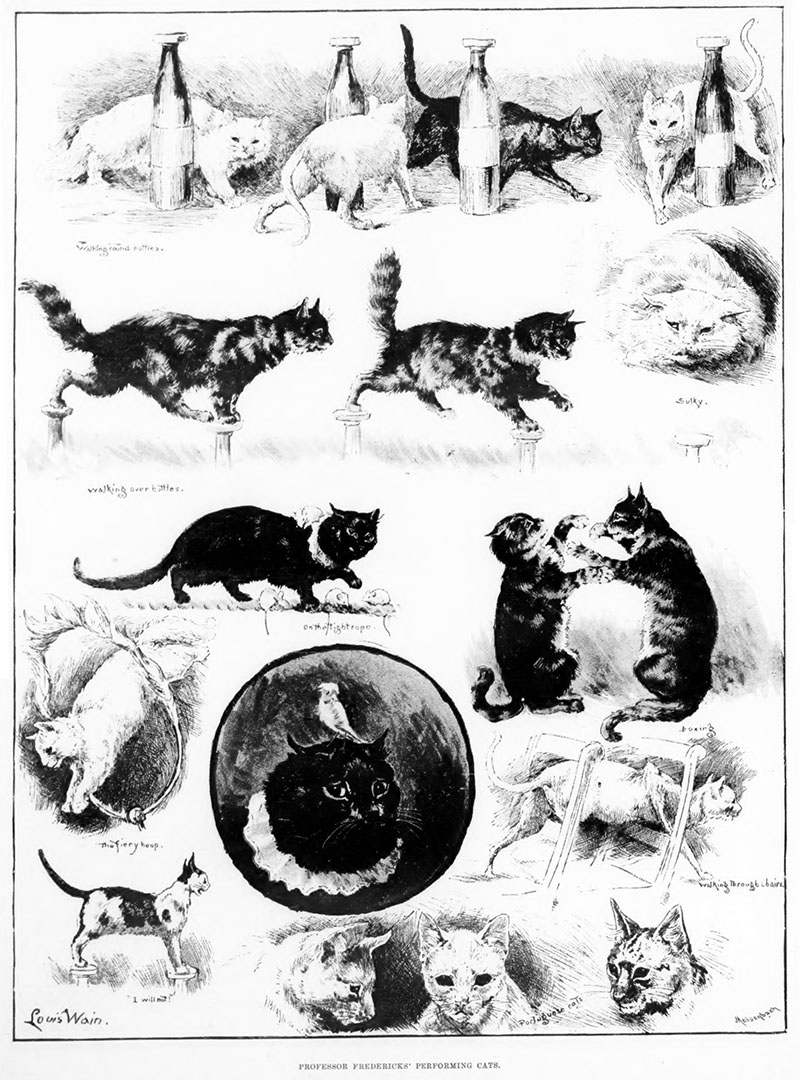
In early 1889 the gloves came off in the ongoing advertisement quarrel and turned into outright accusations hurled back and forth via the pages of The Era. We’re not sure exactly what set it off, but Fredericks felt the need to clarify certain facts and stated them very clearly in an ad published on March 9, 1889:
In answer to questions made by Proprietors, Managers, and Professional Friends, W. Fredericks finds it requisite to make known the following facts: Fredericks’ Performing Cats [FPC] are not the originals, but the first Troupe of Performing Cats that appeared in Great Britain. Fredericks Performing Cats had the honour of appearing before the Royal Family of Portugal in April, 1888. At that time there were only two troupes in existence, Bonnetty’s and Fredericks’. That notwithstanding other advertisements, FPC are at least as good as anything of the kind in the world. That FPC do all that other cats do and require no whip. There is no whip used in this act. That FPC number from Twelve to Fifteen; but there is no law but truth to prevent him calling them Thirty-One. That no part of this act has ever been stopped by a Proprietor or Manager on the score of cruelty. That W.F. will give &0163;50 to any Charitable Institution in England if anyone in the world can prove that any cruelty is used in training or performing these cats. That W.F. having purchased one of the Original Boxing Cats from the Trainer, Mr. J. Bridges, of Westminister-bridge-road. This Cat has had the honour of sparring before H.R.H. the Prince of Wales and Family on several occasions. Not much Street Corner Business about this. That FPC had a full page illustration in the Illustrated London News. That FPC will perform the Baldwin Drop when W.F. has invented a Parachute that will let the cat down without cruelty and without having to be fastened up in a birdcage.
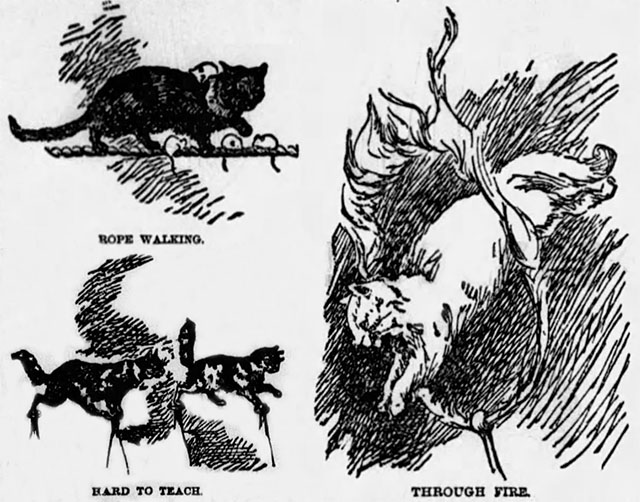
In response to this, Clarke shot back in an ad on March 16, 1889
No whips used; Only feathers and straws. Clarke does not purchase worn-out old Cats. He trains them all himself.
“The Society for the Prevention of Cruelty to Animals have not only seen into the manner in which Clarke trains his Cats, but they have also complimented him. March 8, 1889, An officer of the Society for the Prevention of Cruelty to Animals has witnessed two of Mr. Leoni Clarke’s Performances, and can witness not the slightest act of cruelty in either of them, the “Baldwin Drop” included. Wishing Mr. L.C. every success, Yours truly, Chas. Healey.”
Also The Baldwin Cat, No Cruelty, no Straps, no Fastenings. The Baldwin Cat descends in a Catcage — not a Birdcage — and welcomes its master at the completion of the descent. The Cage constructed for the prevention of torture. Strapping-up avoided. No Straps — No Cruelty.
Clarke has thousands of complimentary critiques from the Press all over England and Europe, but he has not yet paid for a full-page illustration in the Police News or any other paper. £1000 to any one who can prove cruelty. £500 to anyone who can work Clarke’s cats. £100 open to compete with any troupe in the world.
L.C.’s are all Sleek and Well-fed Cats, not Skin and Bone. No Street-corner Business. All Cats Trained by L.C.
Clarke followed this up with longer ads which included poems stating the superiority of his cats and dispelling the claims of cruelty regarding the Baldwin Drop. The feud seemed to slow down and by April 1889 Fredericks branched into creating his own circus with numerous human performers, although his Performing Cats continued to be part of the show. In 1983 Frederick’s Performing Cats were part of Lord George Sanger’s Circus and a monkey had been added to the act.
Leoni Clarke’s popularity continued and even inspired parody. Sir George Robey, a noted music hall comedian usually billed as the Prime Minister of Mirth, had the idea to do a burlesque of Leoni Clarke’s act for a benefit. As reported in Hannen Swaffer’s Who’s Who, when the comedian advertised for some cats at a shilling apiece he was inundated with countless people bearing cats outside the theater. Robey chose about half a dozen and set about teaching them silly tricks, just enough to carry off the semblance of an act without doing too good of a job (what would be the humor in doing the act well?)
On the night of the benefit the curtain ascended, revealing the cats in their cages at the back of the stage and Robey in his trainer’s uniform. He released the cats and was about to address the audience when someone in the seats let out a loud, “Ph-ph-ph-th-t!” In one second the cats had all bolted from the stage in fright. At first Robey was frustrated at the development but soon realized the audience was roaring with laughter. He was quoted later as saying, “To this day, the audience think I planned it.”
Clarke would continue touring with his performing cats for many years, even taking the act to America. But it was there a horrible tragedy befell the troupe which would make national news. Leoni Clarke and his cats, along with his wife Tina and her birds, were performing over Easter weekend at the Center Theater in Philadelphia when the unspeakable incident occured, as reported in the April 27, 1889 of The Philadelphia Inquirer:
Thirteen Are Dead — Leoni Clarke’s Performing Cats Done to Death by Pills
Leoni Clarke, the trainer and exhibitor of the trick cats, rats and mice at the Central Theatre, and his wife, Mlle. Tina, the Bird Queen, were inconsolable last night, for thirteen of the biggest and most intelligent of the cats lay dead — done to death by pills. Last night Leoni Clarke said between his half-suppressed sobs that he would not have taken £2,000 sterling for his dead pets. Mlle. Tina was so overcome with grief that she could not speak.
For the past week the troupe of cats, rats, mice and birds have been giving wonderful performances. The cats gave trapeze, tight-rope and other acrobatic performances; walked on bottles, carried mice and birds on their backs at full speed around a circus ring, and had sham combats with big rats. For three years Leoni Clarke has secretly trained them before he began his exhibitions, and 400 dollars a week was what they netted him.
Both he and his wife loved the Tommies and Tabbies with intense “feline.”
In order to keep them bright and in good condition Mr. Clarke occassionally gave them pills made from a prescription of Bott & Co., Oxford Street, London. Yesterday the cats were a little uneasy and the owner took his prescription to Mitchell’s drug store, Fifteenth and Market streets, and ordered 1,000 pills.
“They’re for cats,” said Mr. Clarke to the drug clerk.
It was just 1 P.M. when Mr. Clarke gave a pill to Fireworks, a big English tortoise-shell, on the stage of the theatre. Then he gave a pill to Moscow, a big Russian, which he valued at 2,400 dollars.
He had just administered a pill to the thirteenth cat when he heard a terrible “Meaow.” He turned around just in time to see Fireworks in paroxysms. He rushed to the struggling cat, picked it up and vigorously rubbed it, but poor Fireworks cast one more imploring glance at his master and was dead.
Then Mlle. Tina rushed to the rescue of Moscow. Tenderly she clasped him in her arms. But poor Moscow was beyond hope and died as had died Fireworks. His corpse was wet with the tears of his mistress.
One after another the favorites died, while master and mistress wept side by side.
Fortunately there was a duplicate of 23 cats left, and although they were evidently affected by their brothers’ and sisters’ death, they went through the performance, even to the daring parachute leap, which was performed by a little Maltese.
The dead bodies were tenderly laid side by side in a wine hamper, and Dr. Leffman will hold a post-mortem examination on Moscow to-day.
Mr. Clarke claims that he has frequently used the prescription without danger before. He will consult a lawyer today.
There were very few follow up stories, the longest of which was published in The Philadelphia Times on April 28, 1889 and went into more details of the tragedy:
Damages for the Cats
Leoni Clarke Will Sue for Ten Thousand Dollars
Post-Mortem Examinations
The Troupe Demoralized by the Fear That the Understudies are Not Proficient in Their Lines
Leoni Clarke has taken the first steps toward avenging the death of the fourteen stars of the feline troop that delighted the patrons of the Central Theatre last week.
He arose early yesterday morning. His rage revived upon reading the account of his loss. His back was up. He asked at his hotel to be directed to a firm of good criminal lawyers. Half an hour afterward he was in the office of James H. Heverin and James Shakespeare.
In another half hour he was walking back to his hotel with a gloomy smile on his face. His lawyers were going to bring suit for $10,000 damages against Marshall Brothers, druggists, at 1215 Market Street. It was there that the fatal pills for the performing cats had been bought.
Legal Light on the Catastrophe
Many grave tales have been brought to the attention of Lawyers Heverin and Shakespeare. They were more than usually moved by the story of the pills. When Mr. Clarke had told his story they assured him that he had a clear case.
There could be no doubt about the value of the property destroyed. Clarke earned $300 a week with his acrobatic Tabs and Toms. The cats were of the purest breeds. It took about four years to train each one to do the startling things that have made Clarke famous in two hemispheres. The understudies for the deceased cats are not in trim. They have not been in active training. Their owner fears that their constitutions will break down under the task of appearing in their cat roles daily.
Mr. Clarke has always believed in giving to educated animals tonics, stimulants and physic, the same as to brainy men. When he left London, two weeks ago, for his cat tour in this country he brought with him a prescription from Dr. George H. Batt [or Bott, as written in previous article?], the famous English veterinarian surgeon. The prescription was for one hundred pills. One of the principle ingredients was nux vomica, which is a species of arsenic. [Another article stated that the prescription called for both quinine and powdered nux vomica. Nux vomica has been known to be administered for a variety of health issues, but contains appreciable amounts of strychnine and brucine, not arsenic.]
An Excuse for the Druggist
Mr. Heverin thought that the druggist might have made a mistake in compounding the medicine for his client. The cat man wanted to lay in a good stock of his invaluable pills, so he called for 1,000 pills instead of 100. In preparing the tenfold dose from the prescription it is thought that the druggist may have made a natural mistake of making it tenfold stronger and thus put into the innocent pills ten times too much arsenic.
One dead cat was delivered yesterday to Dr. Henry Lefmann, the well-known scientist, with instructions to analyze it and report what it contained. Suit will not be entered against the druggists until this expert testimony is prepared.
Mr. Clarke said that one of the doctors at the Jefferson Medical College had analyzed one of the fatal pills and found that it contained enough nux vomica to destroy a company of militia.
A Cat’s Resurrection
The list of victims was diminished by one yesterday. One of the most talented Toms who had devoured the fatal pills turned up in time for the matinee performance. His master called him “Crown,” and he was the most experienced tight-rope walker in the lot.
Whether Crown was thrown in the barrel in Medical Street and escaped the vigilance of the Nineteenth district police force when the scattered bodies were ordered to be removed to burial grounds is not known. He jumped through hoops of fire on the Central stage at two performances yesterday and seemed to be as active as though he had never encountered a drug store.
The King of Cats and his remaining twenty-three performers left the city last night for Pittsburg. The King expects to be on hand when his suit requires his presence.
We could not find the results of this lawsuit (if it ever happened), but Clarke continued to tour with his cats for many years to come. He apparently held no huge grudge against Philadelphia, either, as he returned to perform with Tina in June, just two months after the accident.
Advertising indicates that Tina returned to the U.K. and toured with a troupe of her own titled Tina’s Marvellous Educated Cats, Rats, Mice, Canaries, and Blondin Cats which played at the Crystal Palace in 1890. Leoni Clarke was still touring America, his agent then being S.A. De Parravinci. Through 1890 and touting 50 cats, Clarke toured America, England and back again. By 1983 the act had been redubbed Clarke’s Happy Family and boasted 170 Cats, Rats, Mice, Canaries, Rabbits and Cockatoos.
In 1893 and 1894 Clarke was part of an extravaganza known as Noah’s Ark, described this way in the December 29, 1893 issue of The Yorkshire Herald and the York Herald:
A somewhat daring experiment has been made by Mr. William Holland at Covent Garden Theatre. Instead of pantomime, the stage is occupied by Noah’s Ark; and although every description of beast, bird, fish, and creeping thing is not represented, the collection brought together is sufficiently varied to justify the title given. The chief charm, however, of the occupants of the Ark is that a large number of them are admirable performers. Nothing is more attractive than the feats of the cats, kittens, rats, mice and canaries, which are under the guidance of “the Cat King.” The boxing cats might almost undertake a bout with the lion.
Professor Bonetti appeared to move away from cats and perfected another act featuring foxes and fowls. He even shared billing with these animals alongside Leoni Clarke’s cats in the same 1893 Noah’s Ark extravaganza mentioned above!
Leoni Clarke continued to receive a fair bit of press, interviewed many times by interested reporters who wanted to know the secret of his success. The tragedy in Philadelphia was, understandably, never brought up again. In an article published in The Westminster Budget on March 15, 1895, Clarke again emphasized the importance of kindness in training his feline performers. He also mentioned his boxing cats by name, explaining, “The parachute cat, which climbs up a rope to the roof of the theatre and flies down by parachute, is the second which has done the trick. The first became too fat, and fell into bad ways. It is now Jim Corbett, and boxes Mitchell nightly.” American boxer James J. Corbett had notably fought English boxer Charles Mitchell on January 25, 1894 in a match that was a media sensation. Never one to let a chance at publicity go by, Clarke had duly named his boxing cats after the two combatants.
A review in the March 30, 1895 edition of The Era included a review of Clarke’s performance at The Metropolitan Music Hall and a more detailed description of his boxing cats. “Two of the felines, named respectively Mitchell and Corbett, duly gloved on the forepaws, engage in a boxing contest that afford intense amusement.”
The boxing cats had clearly become a more notable part of Clarke’s act, although he was now utilizing a larger number of animals of a wider variety (including monkeys and kangaroos). One interviewer spoke to Clarke about his work in the August 6, 1895 edition of The Isle of Man Weekly Times (clearly Clarke thought more of his animal performers at this point than he did of women!):
Leoni Clarke and his Menagerie
How he Trains his Cats, etc.
We found Mr. Clarke in his dressing-room, having just finished making his troupe comfortable for the night; and having learned the nature of our mission to his den, Mr. Clarke very courteously gave us a few particulars concerning himself and his methods of work. We expressed our gratification at his exhibition, and he replied:
“Yes, I think it is about the first in its class now before the public. I don’t think anybody else would bother with such a thing. It is the hardest thing in the world to control cats — barring ladies!”
“I suppose you mean that the natural instinct is so strong in cats?”
“Well, yes; there’s something in that. Then, you see, they will do tricks splendidly in the house, but the difficulty is to get them to perform before an audience. There is the noise and the band, and the people applauding in front.”
“It struck me how difficult is must be to get the cats to jump through those flaming lights.”
“Well, it is all education, you know. It took me over four years to train my present lot, and cost me over £800! Of course I was doing another performance all the time. I had a show of 100 performing pigeons, sea-gulls, and every sort of bird you could think of.”
“And how do you work, Mr. Clarke? Do you have to practice your animals?”
“Nobody knows the amount of study and patience I have to use to get this show up. People run away with the idea that you have to beat them to make them learn the tricks. Nothing of the kind! It would only spoil the cats and make them stupid. That boxing cat, ‘Mitchell,’ if you beat him he is just like a dog. He is a very lively chap; he’ll chase the rats and the canaries all over the place. The great idea is to get a trick suitable to the animal’s capabilities, and yet to be original. Lots of men can copy tricks, but it is another thing to invent one. Oh no! I have not always been at this business. I have been 34 years travelling all over Europe with various businesses — circus rider, gymnast, juggler, and I have trained boxing kangaroos. I have had many of them. I sold the last to Bostock for £120.”
“You must understand animals very well!”
“Yes; I guess I can train anything but ladies! I have to draw the line there!”
Speaking of the “Baldwin” parachutist cat, Mr. Clarke . . .
“That is a very old cat, though it looks so small. I have another cat that does the same parachute trick, but I call it the “lightning cat.” He scuds up the rope — buck-jump fashion — so quickly, that half the people don’t see him and ask, ‘What’s he done?’ Yes, I have a Manx cat as well. I show it in the hurdle race. The old cats don’t need any practice, except in the performance. There’s Mitchell now. I can always trust him for anything, and he can do some wonderful tricks.”
Clarke continued to perform with his expanding menagerie all through the end of the 19th century.
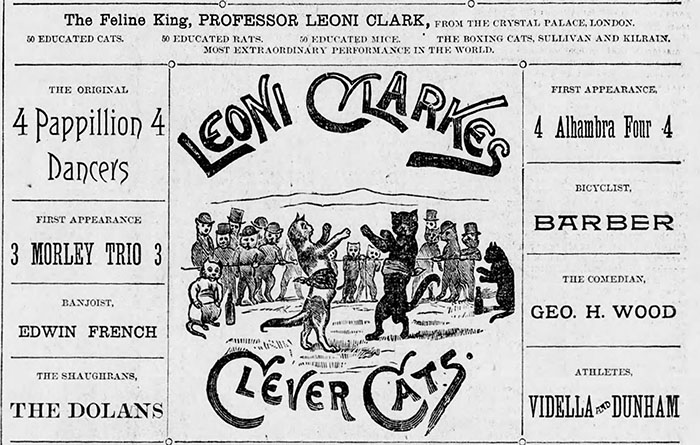
While Bonetti, Fredericks and Clarke may have paved the way for future performing cats, and specifically boxing cats, this was only the beginning. Others were already jumping on the bandwagon, even large circus enterprises. The popularity of boxing cats wasn’t going to fade away any time soon and a new medium was about to bring the practice to an even larger audience!

